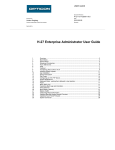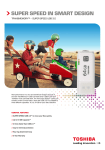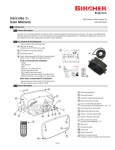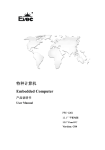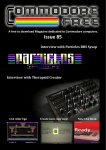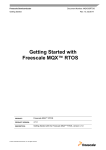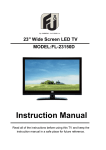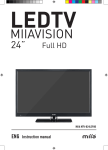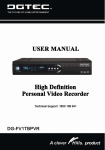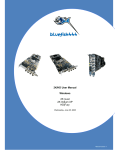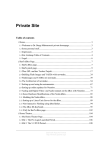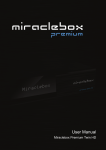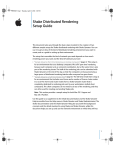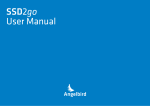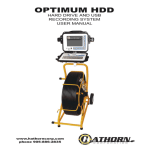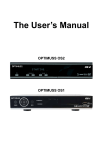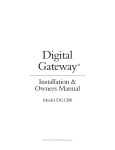Download SOME NOTES AND PICTURES ABOUT PowerBoard Enigma2 IMAGE
Transcript
SOME NOTES AND PICTURES ABOUT PowerBoard Enigma2 IMAGE This notes are intended as a supplement to your PBnigma 'HOW TO' or user manual, which cover various topics in more detail. PB Device Manager and External Storage To make the best use of your receiver and PB image it is recommended to attach permanently external storage, be it fast USB stick, CF, SD or MMC cards via adapter or HDD. Network attached storage (NAS) is somewhat special case and shall be explained later. Common reasons for the above are: Timeshift or timed recordings Additional system space due to limited flash size (PB flash expander) Storage for Picons, as they could (and usually do) take a lot of space Storage for EPG (electronic program guide) data Life prolongation of STB's flash memory (EPG and some other operations) Backup media for your settings (various configuration files, channel lists, etc.) Media storage for your movies, pictures or music Common problems and pitfalls are: Inadequate choice of device, like inferior quality USB stick. Today it is hard to justify use of slowest and cheapest sticks, try to use fast and reliable ones. Sometimes models for USB 3.0 standard are a good and safe choice, but some research is recommended as always. Do not use the old one from last decade, just because you do not need it any more:) For some purposes, like intensive recording or similar high data flow tasks, HDDs might be preferred choice. On the other hand, if you value silence, storing EPG data or picons on USB sticks or similar devices might be a wiser option. Unsuitable file system (see formatting and partition options for PB Device Manager). This could be a confusing one for those who share understandable dislike for finer details of computer, well, stuff:) There are no strict rules, and a few factors (device's firmware, STB's HW and SW capabilities, your intended usage, ideological stance) that invalidate the following, but, in general, recommended file system choices per type of device are: USB stick and other non-HDD devices: ext2, FAT32, exFAT. Note: some newer Picon packages have softlinks, so FAT32 and similar cannot work well for them. Without some advanced settings, FS like ext3 and ext4 do (might) not work well on these devices and shorten their lifespan. If these settings are applied, they negate their advantages. Ext2 could be your best bet, except if you do need frequent exchange of data STB<->Windows based PC via the stick. Still, FTP. Samba, NFS for Win or secondary USB stick might be more prudent for such transfers. See also EXT2FSD and Paragon ExtFS. HDD: ext2, (ext3), ext4, XFS, NTFS. Note: Win NTFS is usually supported in read only mode, need for writing capability could demand usage of NTFS-3G set of programs which does put additional load on your STB and usually results with poor performance. If you really, really do need journaling, use ext4 over ext3 anytime. Need for journaling might be translated to: frequent reboots due to some weird plugins or power losses. SSD HDD: ext4, XFS (ext3) Need kernel versions 2.6.33 (ext4, FAT), 2.6.38 (XFS, ext3) or higher for TRIM support. Discard option is available from kernel 2.6.28. Swap partition is in discard mode by default. Executing fstrim command from crontab, might be preferred to discard option, depending on your recording/viewing habits. Before disconnecting your storage device from STB, be sure to: Stop all timeshit or recording in progress Check that there is no EPG database update pending from EPGimportPB, CrossEPG or similar Use PBeject for temporary removal or PB Device Manager for absolute removal of the device Failure to comply with the above procedure may (actually, considering Murphy's Law, very likely shall) result with loss of your precious data. In some cases, STB shutdown may be needed. Meaning deep standby, NOT brute force power off via mains switch. Side Notes: EPG Cache: After sorting out and mounting your external devices in PB Device Manager, a reboot might be needed before setting EPG data location in MENU → SETUP → SYSTEM → EPG → EPG SETTINGS → EPG location: Try to avoid using internal flash for EPG location! Using external, mounted device could give prolonged life to your receiver. Some providers (perhaps most of them) do not provide multiple next events OTA, just current and very next. It is likely that you might prefer to use plugins like EPGimport (PB version might be pre-installed in some images) or CrossEPG- Downloader. EPGimport PB is based on Rytec providers, CrossEPG has an additional, so called, XEPGDB format that may download faster. Choice between the two is up to you and your needs. Please note, that it is not recommended to use both of them simultaneously. Selecting too many EPG providers (eg. for motorized dish or T90) or too many days in advance (in case of EPGimport) might have serious impact on your receiver's performance and boot times. YMMV. Both do offer an unattended, scheduled EPG download, as well as other extras, much better described elsewhere. Picons: In a somewhat similar way, mounted USB or other external device is recommended for storage of Picons. Of course, if you have abundant free space in flash/NAND, you could store them in the root of your STB, as they are static in nature, in other words they are not periodically updated like EPG data. Beware that Picons could take a lot of space, dozens of megabytes, and new versions require file system that supports soft links, like ext2, but NOT FAT32. Picons could be installed from MENU → PLUGINS → (GREEN BUTTON) DOWNLOAD PLUGINS → expand picons section and choose the set that you need or is recommended by your favorite skin. If your external device is properly mounted, you should see a similar view: TransMemory, shown here is an external USB stick. Upon pressing OK, picons of your choice should be downloaded and installed from PB feeds. Extensive use of picons could slow down your receiver a bit, especially if low on memory or SoC/CPU resources like in single core-single thread boxes. As always YMMV. An additional picon feed from Ocram may be enabled in POWERBOARD CENTRE → POWERBOARD SETUP → Ocram feeds active yes/no. This option is not enabled by default because of sporadic dropouts which affect other feeds. If you experience delays while using SOFTWARE MANAGER, or PLUGIN BROWSER → DOWNLOADS, please do try and set this option to no as seen here: Skins: PbmcHD, PbPrintHD, MintPrintHD, BluePrintHD and to some extent OneKeyBlue are PB developed skins, carefully crafted to bring the best out of your STB. XxPrintHD series may be better suited to less able receivers like single core/thread or SH4, but do not take this as a firm rule. Here is a simple overview of some skins from PB feeds: PbmcHD BluePrintHD MintPrintHD PbPrintHD OneKeyBlue Fallback default skin Lcars Swain-HD Novum_HD2 MyMetrixHD BlueHD Bootlogos: MENU → PLUGINS → (GREEN BUTTON) DOWNLOAD PLUGINS → expand skins and look for bootlogos-pbxxxx or POWERBOARD CENTER → SOFTWARE MANAGER → MANAGE EXTENSIONS → expand skins and look for enigma2-plugin-bootlogos-pbxxxx Preview : pbblue pbchili pbbluespirit etc...











